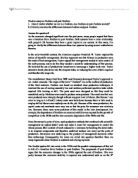The role of labour in the 2 systems is very different. Fordism allows the worker to concentrate on just one simple task, where as post-Fordism workers are expected to carry out multiple tasks. Fordism allows workers to specialise. Under Fordism, workers found their responsibilities diminishing. Assembly line work is unpleasant in a mass production environment. It is physically demanding, requires high levels of concentration, and can be excruciatingly boring. As a consequence, Ford experienced very high labor turnover, 380 percent in 1913. During post-Fordism, there is an emphasis on worker's co-responsibility and the labour market is flexible. Employees of a Fordism regime were employed full time, had job security and benefits. Post-Fordism employees are often part time or temporary, with no job security or benefits. Centrailised production and strong unions are key features of Fordism, compared with de-centralised production and weak unions associated with post-Fordism. Flexible production dramatically reduced the demand for unskilled labor. Flexible production requires numerate and literate workers, capable of a high degree of self-direction. As a consequence, the number of unskilled industrial workers in the developed world has been falling for nearly thirty years.
Henry Ford operated a high degree of social control. He tried to stop his workers from wasting their money on alcohol, cigarettes and gambling. An ex-boxer was hired to head the Service Department and a private police force was employed to install discipline a preventing an active Trade Union. Workers were not allowed to talk to each other at work or during the lunch break.
Fordism relies upon strong local, regional and national control, but post-Fordism doesn’t have any of these features. Flexible specialisation is regulated by organisations such as the EU, World Trade Organisation and IMF.
Henry Ford was also keen to make machines interchangeable and easy to repair. He achieved this by creating “standardisation”. He exploited advances in machine tools and gauging systems. These innovations allowed Ford’s factory to run on a continuous assembly line.
The production process during Fordism was resource driven, compared to the demand driven post-Fordism regime. Mass production and consumption are key to the Fordism regime. Vertical and horizontal integration occurred during Fordism, while post-Fordism preferred to sub-contract work to smaller firms.
The aims of Henry Ford were to encourage growth of the domestic market by matching domestic production to domestic demand. He wanted to use low cost labour and resources, and aimed to develop international trade. Post-Fordism production often occurs in third world countries, where it is cheaper and safety and environmental standards are lower.
The decline in mass production has resulted a fall in mass consumption. Producers no longer produce standardised products at the lowest possible cost. Instead, final products now reflect consumer tastes and preferences. A good example of flexible specialisation is Dell computers. They will build a PC to your exact requirements, rather than just trying to sell one or two configurations.
Fordism and post-Fordism are two very different methods of work organisation. There are huge differences in type of labour required for the two methods, as well as their duties and responsibilities. The methods of control also vary greatly.
Bibliography:
Watson, T (1987) Sociology, Work and Industry
Grint, K (1998) The Sociology of Work
Hall, S and Gieben, B (1992) Formations of Modernity
Lecture notes
Word Count - 692







